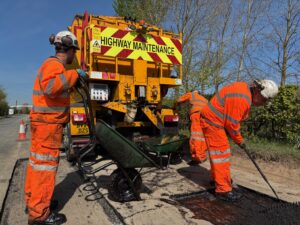Following on from the Highways Voices podcast on protecting and preserving the network, Richard Ashton, Market Development Manager for the Bitumen division of TotalEnergies Marketing UK has written this post for Highways News:
The AA recently released a warning to drivers to beware of the road surfaces lurking underneath standing water as it attended an extra 225 potholed related breakdowns since the beginning of November. Richard Ashton reflects on what the news suggests about the local roads maintenance in England and Wales, and how the issue can be tackled.
What does the AA’s warning suggest about the current state of the road network in England and Wales?
This warning reflects the sense of urgency indicated in the Asphalt Industry Alliance (AIA) ALARM Survey which was published earlier this year, with a worsening backlog of repairs – despite a pothole being filled every nineteen seconds. Filling potholes is a symptom of failure not prudent highways asset management. Reactive maintenance is twenty times more expensive than preventive maintenance. The surface dressing treatments historically used to delay the onset of potholes have been declining over the last decade as focus has shifted to setting KPI’s around pothole reactivity. The result is local authorities reacting to potholes that would have previously been arrested at micro cracking stage by surface treatments sealing surfaces at the correct intervention period.
How can the tackling of potholes make things safer for road users, as well as help reduce the overall carbon footprint of the network?
Potholes form in the nearside wheel-track near the kerb where vulnerable users – cyclists travel. The reason – road camber and drainage. Water is moved to this area to be taken via grids. Grids block through extreme weather or lack of maintenance forming puddles. Passing vehicles pressurises water into the surface – pressure washing. Surface degradation follows starting potholes. Freeze / thaw cycles accelerate deterioration. Keeping gullies clear and drainage efficiently removing water stops the potholes. One pound saved on reduced gully clearing frequency costs many more in pothole repairs later. Keeping surfaces sealed with high quality regularly surface dressed asphalt prevents disease before a cure is needed. Protecting roads before deterioration delays more serious structural intervention and the subsequent carbon costs from deep repairs which are often short-term solutions.
How do these industry calls to action highlight the level of urgency required to make significant improvements to the roads?
Climate change is a factor past engineers could ignore. Extreme weather, now frequent means roads need resilience to regular flooding. This requires more durable materials to achieve the same or greater service life achieved historically. Innovative materials such as porous asphalts can use more advanced polymer modified bitumen such as TotalEnergies Styrelf bringing ‘sustainability through durability’. Polymer modified asphalts incorporating carefully selected recycled constituents can extend life cycles contributing to a circular economy and carbon reduction goals.
(Picture – Highways News)






















